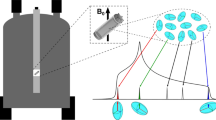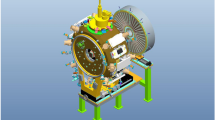Abstract
Pulsed NMR measurements of the nuclear susceptibility of liquid He3 at various molar volumes are presented over the temperature range between 0.035 and 1°K. The scatter in the data is about 0.2%, while the absolute accuracy is estimated to be about ±1%. At temperaturesT such that χ0 T/C≲0.35 the susceptibility data can empirically be represented by the expression χ=χ0[1−β(x0 T/C)2]. Here χ0 is the extrapolated molar susceptibility atT=0 for a given volume, assuming the expression to be valid below 35 m°K.C is the molar Curie constant and β is a factor that appears to be somewhat dependent on molar volume and whose average value is found experimentally to be about 0.53. This result compares with the theoretical prediction by Béal-Monadet al. who used the paramagnon model for liquid He3 and obtained the expression given above with a value of β=0.58. However, the observed apparentT 2dependence of the susceptibility is over a greater temperature range than the theory would lead one to expect, and this point is discussed. The experimental results are also compared with a “molecular-field” approach by Goldstein, who proposed a representation of the susceptibility by a universal curve χT/C=f(χ0 T/C), wheref is the function for the ideal gas. In spite of some systematic discrepancies, a scaled presentation of the data is in good overall agreement with the calculated curve. The data disagree with the Stoner model of a Fermi gas with interactions. Finally, the values of χ0 are compared with those of previous work.
Similar content being viewed by others
References
A. C. Anderson, W. Reese, and J. C. Wheatley,Phys. Rev. 127, 671 (1962).
A. L. Thomson, H. Meyer, and E. D. Adams,Phys. Rev. 128, 509 (1962).
B. T. Beal and J. Hatton,Phys. Rev. 139, A1751 (1965).
See, e.g., A. A. Abrikosov and I. M. Khalatnikov,Soviet Phys. Uspeki 66, 68 (1958);Rept. Progr. Phys. 22, 329 (1959).
S. Doniach and S. Engelsberg,Phys. Rev. Letters 17, 750 (1966); D. J. Amit, J. W. Kane, and H. Wagner,Phys. Rev. Letters 19, 425 (1967).
E. C. Stoner,Proc. Roy. Soc. A152, 672 (1935); J. McDougall and E. C. Stoner,Phil. Trans. Roy. Soc. London 237, 67 (1938).
T. L. Jordan and K. R. Crandall (unpublished).
L. Goldstein,Phys. Rev. 133, A52 (1964).
E. C. Stoner,Proc. Roy. Soc. A153, 656 (1936).
P. M. Richards,Phys. Rev. 132, 1867 (1963).
W. R. Abel, A. C. Anderson, W. C. Black, and J. C. Wheatley,Phys. Rev. 147, 111 (1966).
M. T. Béal-Monod, S. K. Ma, and D. Fredkin,Phys. Rev. Letters 20, 929 (1968), and private communication.
J. C. Wheatley, “Experimental properties of pure He3 and dilute solutions of He3 in superfluid He4 at very low temperatures,”Progress in Low-Temperature Physics, Vol. VI, (C. J. Gorter, ed.) (to be published). See also William E. Keller,Helium-3 and Helium-4 (Plenum Press, New York, 1969), Chapter 6. See also S. Doniach,Proc. Eleventh International Conference on Low-Temperature Physics, (J. F. Allen, D. M. Finlayson, and D. M. McCall, Eds.) (St. Andrews University Press, 1968), p. 76.
D. Fredkin, private communication.
J. R. Thompson, H. Ramm, J. F. Jarvis, and H. Meyer,J. Low Temp. Phys. 2, 521 (1970) (the preceding paper in this issue).
R. C. Richardson, E. R. Hunt, and H. Meyer,Phys. Rev. 138, A1326 (1965), as corrected inJ. Appl. Phys. 39, 390 (1968). The volume dependence of the exchange integral so found has been confirmed by Panczyk and Adams [Phys. Rev. 187, 321 (1969)], who obtained more accurate values ofJ from (∂P/∂T) v measurements, and also by the authors of Ref. 17.
See, e.g., W. P. Kirk, E. B. Osgood, and M. Garber,Phys. Rev. Letters 23, 833 (1969), and references therein.
M. G. Richards, J. Hatton, and R. Giffard,Phys. Rev. 139, 91 (1965).
E. R. Hunt, R. C. Richardson, J. R. Thompson, R. A. Guyer, and H. Meyer,Phys. Rev. 163, 181 (1967).
R. Giffard, Thesis, Oxford University, 1968 (unpublished).
W. C. Black, W. R. Roach, and J. C. Wheatley,Rev. Sci. Inst. 35, 587 (1964).
P. Lawless, private communication.
C. Boghosian, H. Meyer, and J. E. Rives,Phys. Rev. 146, 110 (1966).
W. F. Brinkman and S. Engelsberg,Phys. Rev. 169, 417 (1968).
See, e.g., J. M. Ziman,Electrons and Phonons (Oxford University Press, Oxford, 1960), Chapter 1.11, p. 52, and references therein. See also H. H. Sample and C. A. Swenson,Phys. Rev. 158, 188 (1967).
Author information
Authors and Affiliations
Additional information
Research supported by grants from the National Science Foundation and from the Army Research Office (Durham).
Rights and permissions
About this article
Cite this article
Ramm, H., Pedroni, P., Thompson, J.R. et al. Nuclear susceptibility of liquid He3—II. J Low Temp Phys 2, 539–553 (1970). https://doi.org/10.1007/BF00628273
Received:
Issue Date:
DOI: https://doi.org/10.1007/BF00628273




